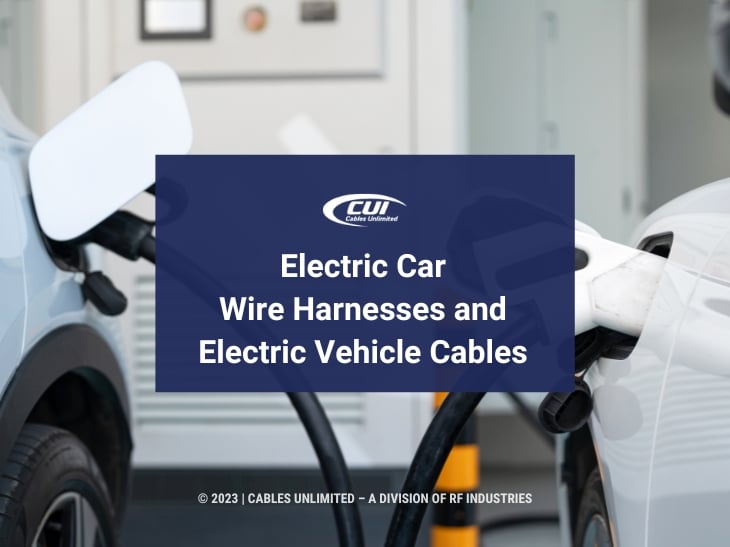Nearly seven million plug-in and electric vehicles are currently on the road in the U.S.A. In California alone, there are almost 500,000 registered electric vehicles. But the state is expected to exceed four million by 2030. Given that phenomenal growth, the demand for electric car wire harnesses and electric vehicle cables has grown substantially.
Not just any automotive wires and cables will work. Instead, custom wire harnesses are required that consider significantly different requirements. Here we examine those needs and how we fulfill these critical electric vehicle cable manufacturing requirements.
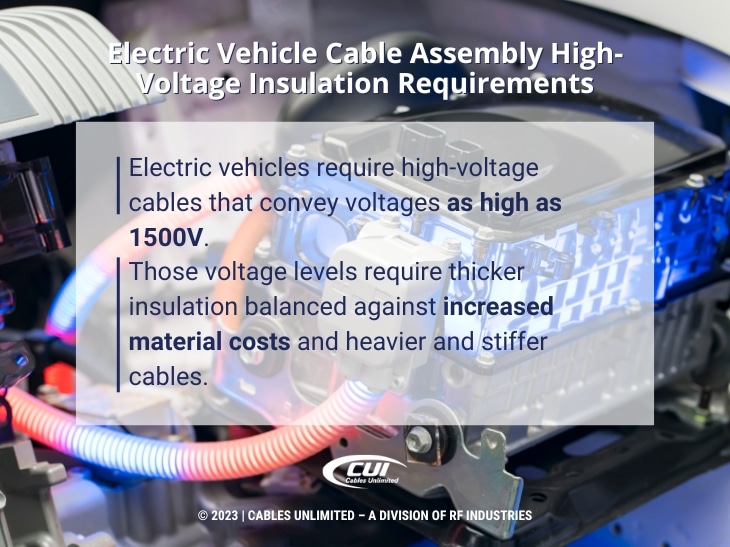
Electric Vehicle Cable Assembly High-Voltage Insulation Requirements
Typical automobiles require low-voltage cables, running up to 60 volts. However, electric vehicles require high-voltage cables that convey voltages as high as 1500V. This presents a considerable safety risk for those driving and, indeed, those servicing electric vehicles.
Those voltage levels require thicker insulation balanced against increased material costs and heavier and stiffer cables. Weight adds up in an electric vehicle and can seriously limit performance and range. Plus, stiffer cables are more challenging to route within the car.
Temperature range and chemical exposure are critical factors for high-voltage insulation. Fluoropolymers, including ETFE (ethylene tetrafluoroethylene) and FEP (fluorinated ethylene propylene), are rated to 150ºC, while PFA (perfluoroalkoxy alkane) is rated to 180ºC. Silicone rubber jackets can also be used, with EPDM (ethylene propylene diene monomer) rated from 100 –150ºC. Unfortunately, silicone insulation does have an increased risk of failure when exposed to battery acids.
Electric Vehicle Cable Management and Shielding Requirements
On top of the required insulation to address high voltages, there are also shielding requirements due to the nature of the signals on those cables. The high-power electric motors used in these vehicles are driven by PWM (pulse width modulation) signals at very high frequencies.
These pulses generate electromagnetic interference (EMI) that is then radiated by the cables acting as antennas. That type of interference via crosstalk can wreak havoc on electric vehicle systems, from GPS to electric braking systems, entertainment systems, and even automated driving systems. EMI and EMF (electromagnetic field) can also pose health threats to the occupants of the cars.
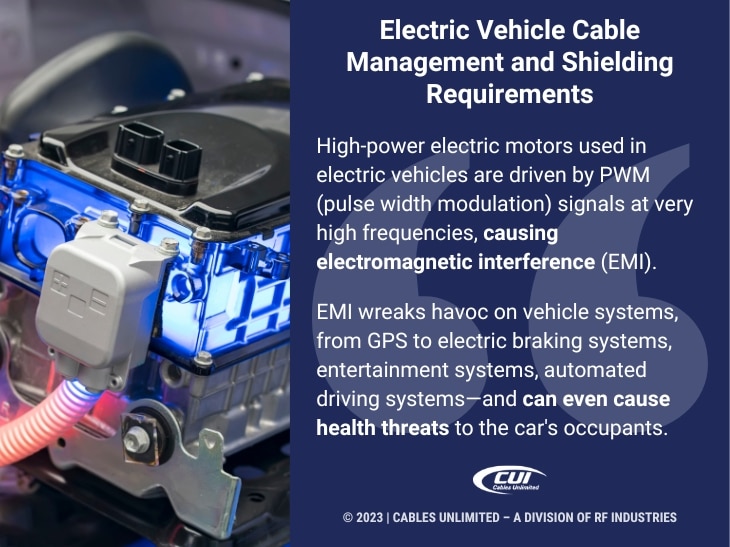
The solution is to provide shielding for those wires handling PWM signals. But, of course, those cables handling DC for the battery do not need shielding. Several types of shielding can be used. They include copper braid specified for coverage from 70% to 95%. The higher the percentage of coverage, the greater the EMI protection and the greater the cost and weight. An alternative is an aluminum foil layer that provides 100% coverage and is lightweight. Foil and braid can also be combined to address EMI shielding requirements further.
Electric Car Wire Harnesses for Low-Voltage Systems
Typical automotive systems have relied on 12VDC to power lighting, radios, air conditioning, and sensors. Yet, electric vehicles are now being designed and built with 48VDC systems. While this doesn’t come close to the requirements posed by 1500V systems noted above, it requires attention to the insulation and conductor.
Typical insulation materials include lower-cost PVC or other thermoplastics. But these lower voltages often require high currents, which means a much larger wire gauge conductor. Some battery connections use extruded solid metal bars as conductors.
Copper is usually the metal of choice for wires and cables due to its high level of conductivity. But the overall use of copper within electric vehicles is relatively high compared to conventional automobiles. For example, internal combustion cars use 19 to 48 lbs of copper, while battery electric vehicles use 183 lbs. That adds cost and weight.
Both those factors have been driving further use of aluminum. Aluminum is far more cost-effective than copper, with more than 50% weight savings. But it doesn’t have the conductivity level of copper. Yet this can be overcome by using larger diameter conductors to reduce resistance to match an equivalent copper conductor.
Read more in our blog: Copper Wires and Cables: History of Costs and the Coming Explosion of Demand
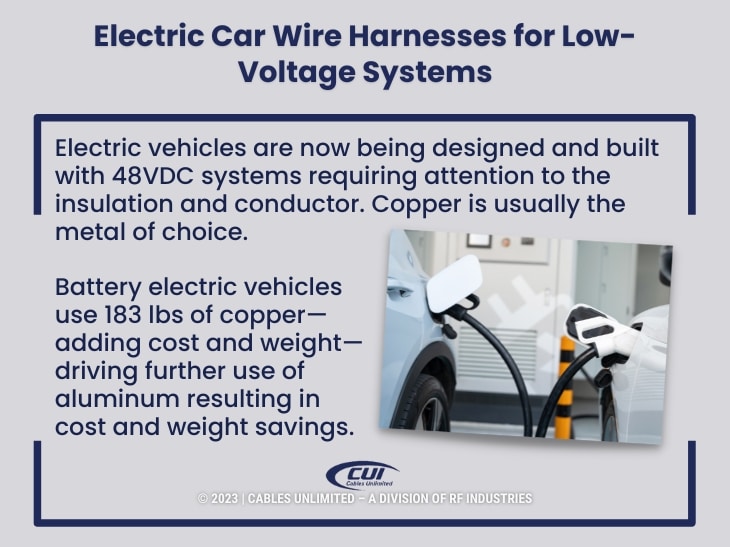
Quality Control and Testing Requirements for Electric Car Wire Harnesses and Cables
As with any cable assembly or wire harness, rigorous quality control backed up by testing and certification is required before anything is shipped and installed. The ISO 6722-1 standard defines a broad range of tests that lead to certification. Here’s a starting list of the required tests.
- Heat Age Testing. This involves 3,000 hours of heat age-testing at a specified temperature. A qualified material should last tens of thousands of hours of vehicle use.
- Thermal Resistance. Related to heat age testing, the cable is heated over days, cooled, and tested for electrical and physical properties to ensure it remains at its rated performance. This is also referred to as a burn-in test.
- Tensile Strength. This requires stripping some insulation from the cable and stretching it to the breaking point. There are both break strength and elongation requirements.
- Adherence Testing. This tests for the force required to remove the insulation from the conductor. This is important for setting up cutting and stripping equipment.
- Spark Testing. Here a cable is run through a curtain of metal beads with a high voltage of up to 10,000 volts applied to the curtain. Any fault in the insulation will cause a spark from the curtain to the conductor.
- Abrasion Testing. This test uses a sandpaper device that rubs against the cable. The measurement is how much abrasion it takes to go through the insulation.
- Scrape Testing. Related to abrasion testing, this involves rubbing electrified metal against the cable and noting when the test metal shorts the cable’s conductor.
- Pinching and Crush Testing. Here testing devices determine the force required to pinch or crush the cable.
- Chemical Tolerance Testing. Water, oil, and battery acid are present in any automobile and can be dangerous. This test involves exposing the cables to various substances and measuring the impact.
- Diameter Measurement. Laser sensors check the cable size with very tight tolerance levels. This ensures cables will fit when run inside the vehicle.
Find out more in our blog: Critical Manufacturing Options for High-Temperature Cables
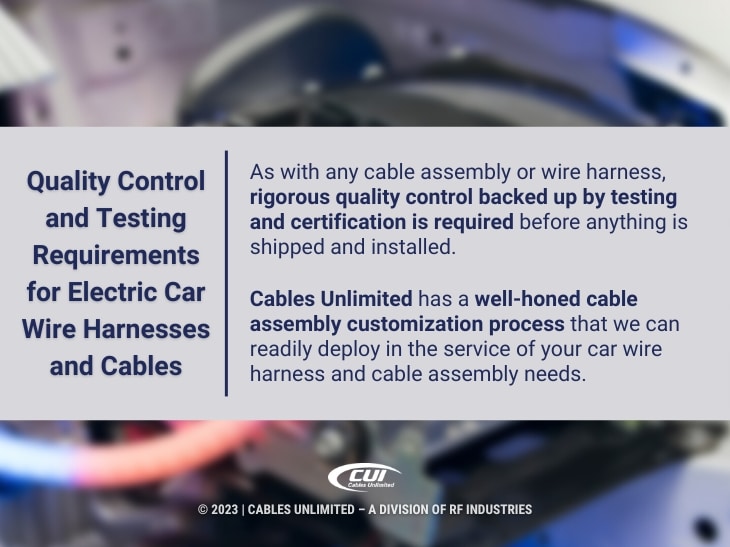
We Can Meet Your Electric Car Wire Harness and Cable Assembly Needs
We have a well-honed cable assembly customization process that we can readily deploy in the service of your car wire harnesses and cable assembly needs.
If your requirements are already specified and ready for a quote for your current projects, we are prepared to meet your deadlines and pricing targets. Our extensive in-house services and advanced manufacturing capabilities are in place to meet your requirements.
But Cables-Unlimited offers much more than state-of-the-art manufacturing – our dedicated team is also known for going to great lengths to meet the needs of our customers, including working round-the-clock to meet tight turnaround time requirements.
Our sales representatives are standing by to assist you with product questions and quotes Monday – Friday, 8:00 am to 5:00 pm Eastern. Of course, you can also email us or complete our contact form, and we’ll get right back to you.

